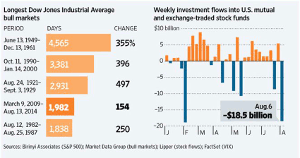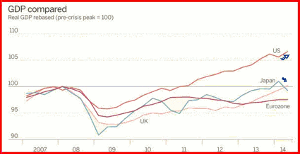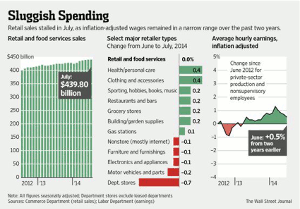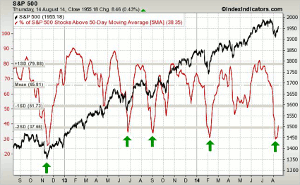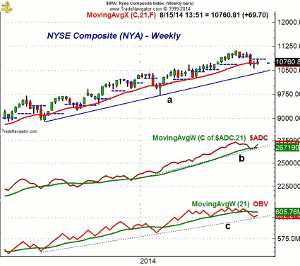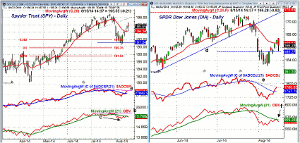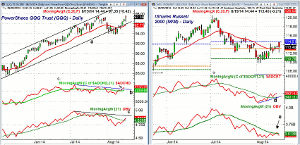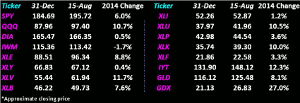Many strategists are concerned about the length of the current bull market but there have been three bull markets that have lasted longer, so MoneyShow's Tom Aspray turns to the charts to see if traders should expect more downside in the coming weeks before seeing a bottom.
As I discussed last Thursday, the AAII "bullish percentage jumped from 30.89% to 39.81% last week, while the number of bears dropped sharply from 38.23% to 26.96%." I pointed out that "the reversal in sentiment is consistent with a rebound in a downtrend and not the resumption of the major uptrend."
Sentiment can be difficult to measure as the data from AAII on the individual investor is used as a contrary indicator. I typically look for extreme low bullish % and high bearish % readings to help me to look for technical signs of a market bottom.
Often times, the bullish % will drop into the 20-23% range before a bottom is completed. The Fear & Greed Index, that I featured last week, did improve slightly from 4 to 11 but is still in Extreme Fear territory.
Late last week, I came across an interesting article about institutional sentiment in the Wall Street Journal. It pointed out that one of Merrill Lynch's most reliable indicators is also a contrary indicator. In the article, they pointed out that when Wall Street strategists recommend a lower percentage in stocks it is a bullish sign. "For Merrill, average recommendation below 54% is a buy signal."
Currently, strategists recommend just 51% in stocks which "forecasts a 22% stock gain in the next 12 months." They also noted than money managers are holding the highest level of cash since June 2012. Stocks had topped in early May 2012 and declined sharply on fears over the euro debt crisis. The stock market showed signs of a technical bottom (Rally Potential That Bears Don't Expect) in early June of 2012.
In 2012, the % of bullish investors dropped to 23.58% on May 27 and was at 27.45% the week the market made its lows. On the chart, you should also note that $18.6 billion came out of stock mutual funds and ETFs in early August. This was the highest outflow since the market low in early February.
Many strategists are concerned about the length of the current bull market as well as their view that valuations are too high. There have been three bull markets that have lasted considerably longer.
In looking at sentiment, many pros like John Person also look at the futures positions in the COT report. The report comes out every Friday but, based on the August 8 data, he commented that "the small speculators were still long, the hedge funds were neutral, and the commercials are short." This suggests to him that we will see "more choppy trading in the stock market with a downward bias."
All of the major world markets started off strong last week but Friday's news that Ukraine had apparently destroyed part of a Russian convoy hit the markets hard. The daily chart shows that early Friday the DAX had an early morning high of 9324 just above the declining 20-day EMA at 9321. It also came close to the 38.2% Fibonacci retracement resistance at 9340 before reversing to the downside. It closed 230 points below the day's high on Friday.
Technically, there are still no signs of a bottom for the DAX as the MACD-His made lower lows in early August. It could form a positive divergence if the DAX drops below the recent low at 8903 and it does have good support in the 8800 area.
The economic news out of the Euro zone last week has some worried that they could be slipping back into a recession. As the chart shows, Euro zone growth was flat in the 2nd quarter and it was also reported that inflation dropped to a four and a half year low.
Though this cannot be ruled out, I expect the ECB to act further on rates in early September and think this is just a normal pause in a weak recovery. Since 2009, there have been many times when economists felt that the US was slipping back into a recession and these often coincided with stock market lows. Recent data shows that Japan's GDP has turned lower while both the US and UK are still rising nicely.
NEXT PAGE: What to Watch
|pagebreak|The US economic data last week was not great as Retail Sales were flat in July as-while there was spending on health/personal care and clothing-department store sales were 0.7% weaker than June. The stock of Macy's, Inc. (M) was hit hard last week as they lowered their sales forecast for the year.
I have been expecting better Retail Sales numbers for a few months and if it does not pick up with back to school sales I will be more concerned. Unfortunately, there was little wage growth as it is up just 0.5% from 2012.
Also last Friday, the mid-month reading on Consumer Sentiment from the University of Michigan showed a surprising drop to 79.2 from 81.8 in July. The Empire State Manufacturing Survey indicated a slowdown in the region. On the plus side, Industrial Production was up 0.4% which suggests that manufacturing is leading the recovery.
This week we get a new reading on the struggling housing market with the NAHB Housing Market Index which improved nicely last month. It reflects not only the demand for housing but also the builder's outlook for the overall economy.
On Tuesday we get the CPI report as Producer Prices declined in July. The latest data on Housing Starts will also be released followed on Wednesday by the FOMC minutes.
For the week, Thursday may be the key as we get the PMI Manufacturing Flash report, the Philadelphia Fed Survey, Leading Indicators, and Existing Home Sales.
What to Watch
There have been some significant changes in the technical outlook since last week but there are still not clear signs that the correction has run its course. The major averages reached our upside targets Thursday and rebounded nicely after Friday's mid-day decline.
Amongst the four index tracking ETFs that I regularly follow, only the PowerShares QQQ Trust (QQQ) has completed its correction in terms of the advance/decline line. The volume analysis is still lagging and needs some work to confirm that the worst of the selling is over.
The most positive development was the turn around in the five-day MA of the % of S&P 500 stocks above their 50-day MAs. It topped out in early July after reaching a high risk level above 80%.
It has now turned up from the 30% level (low risk) suggesting that the worst of the selling may be over. This does not mean that the S&P 500 cannot drop back to or below its recent lows but it is a positive sign. The arrows on the chart show that similar signals have occurred at all of the recent market lows.
The weekly chart of the NYSE Composite (NYA) shows that it tested the monthly pivot at 10,852 last week before prices softened at the end of the week.
The weekly NYSE Advance/Decline has turned up after dropping back to its WMA and the short-term uptrend, line b. This is an encouraging sign as the A/D line did confirm the early July highs, consistent with a positive long-term trend.
The weekly OBV has also tested important support but is still below its WMA, which is flattening out. It needs to strengthen further in order to turn positive.
The McClellan Oscillator (not shown) reached the +150 level last week before turning lower. I will be watching how it acts on a drop back towards the zero line.
There is initial support now in the 10,550-10,640 area.
NEXT PAGE: Stocks
|pagebreak|S&P 500
The Spyder Trust (SPY) has had a nice rally off the quarterly pivot at $191.24. The 20-day EMA has been decisively overcome and is now at $194.34. This represents first support with stronger at $192.50-$193.
The stronger resistance in the $196.50 area has been tested with Friday's high at $196.67. The former support-now resistance-is in the $197.50 area.
The S&P 500 A/D line has moved back above its WMA but is still below the key resistance at line a. The market internals overall were stronger than prices last week but this resistance needs to be overcome to turn the A/D line positive.
The on-balance volume (OBV) dropped back below its WMA on Friday as the rebound fell well short of the strong resistance at line b. The lower lows in the OBV (line c) are not a positive sign.
A daily close above the resistance at $198.50 would be bullish.
Dow Industrials
The SPDR Dow Industrials (DIA) dropped down towards the monthly pivot at $165.27 on Friday's sell-off. It rallied from Friday's lows but still closed lower. A close below Tuesday's low at $165 will return the focus on the downside. There is stronger support in the $163.50-$164 area.
The Dow Industrials A/D line moved back above its WMA last week and just reached its downtrend, line e. If a pullback holds above the WMA and the A/D then turns higher, it would be a bullish setup.
The daily OBV just reached its declining WMA (point f) and then turned down. This is typical of a rebound within the downtrend.
Nasdaq 100
The PowerShares QQQ Trust (QQQ) made a new rally high on Friday and may close at a new yearly high. The monthly projected pivot resistance is at $99.27 with the weekly starc+ band at $100.31.
The 20-day EMA is now at $95.69 with further support in the $95 area. The more important support in the $93.60-$94.20 area did hold on the recent drop. The monthly pivot is at $92.82.
The Nasdaq 100 A/D line was able to close above its downtrend, line b, last week, which is a typical sign that the correction is over. Its WMA is also now flattening out but it needs to stay above its WMA on any pullback.
The OBV does not look as positive as while it is also above its WMA, it is still well below the resistance at line c.
Russell 2000
The iShares Russell 2000 Index (IWM) rallied up to its quarterly pivot at $114.61 last week and-despite the early decline Friday-did close well off the lows.
The daily Russell 2000 A/D line is in a short-term uptrend, line d, and is above its WMA that is starting to flatten out. A close back above the $116 level is needed to stabilize the chart.The daily OBV has just moved slightly above its WMA last Thursday but then dropped back below it on Friday (point e).
There is a band of support now in the $111-$112 area.
NEXT PAGE: Sector Focus, Commodities, and Tom's Outlook
|pagebreak|Sector Focus
The iShares Dow Jones Transportation (IYT) closed with nice gains for the week but did close barely lower on Friday. It is still a market leading ETF as it is up over 12% for the year.
The daily technical studies are not yet firmly positive with stronger resistance now in the $149.50-$150 area.
The weekly OBV has turned up from its WMA, which may mean that the correction is over.
Most of the ETFs have rebounded nicely with the Spyder Trust (SPY) up 1.4% for the week and 6% for the year. The PowerShares QQQ Trust (QQQ) is back in double digit territory as it closed Friday at a new high for the year.
The SPDR Dow Industrials (DIA) is still lagging but is now slightly positive for the year.
The Select SPDR Energy (XLE) did rebound Friday but is still well below its recent highs as is the Select Sector Utilities (XLU).
The money seems to be flowing back to health care as the Select Sector Health Care (XLV) is now up 11.7% for the year. The Select Sector Technology (XLK) is also now showing double digit gains this year.
Interest Rates
The yield on the 10-Year Treasury Note closed at significant new lows. It is still holding above the 50% retracement resistance at 2.239%. The potential bottom in yields has been aborted.
Crude Oil
The October crude oil contract rebounded Friday from the week's lows on the news of the possible conflict in the Ukraine. The daily OBV has moved back above its WMA, which is an encouraging sign.
Precious Metals
The Market Vectors Gold Miners ETF (GDX) closed the week a bit higher while the SPDR Gold Trust (GLD) was a bit lower. Still a sideways pattern that suggests caution for now.
The Week Ahead
The rebound I was expecting since August 7th's Get Ready for a Rally has reached the key resistance levels as the SPY has hit the $196.50-$197 area. The improvement in the Nasdaq 100 suggests that the worst of the selling could already be over.
If there is any concrete news from the Ukraine that reflects a worsening of the conflict then Monday stocks could get hit hard, especially in the Euro zone. Many are worried about the contagion spreading to the US so it is not the time to be chasing the market.
I still think you should be long stocks but the allocation should be based on your individual level of risk tolerance.
I don't mean to sound like a broken record but I continue to think that those who are invested in stocks will be pleased in the last quarter of the year. So there is no change for those who are in the process of a dollar-cost-averaging plan as I would definitely stick with your plan. If you have not started one yet, it is still not too late to start.
The improvement in the technical studies for the PowerShares QQQ Trust (QQQ) does not favor trading the short side of the market so traders keep your powder dry.
Don't forget to read Tom's latest Trading Lesson, Three Reasons to Sell.

